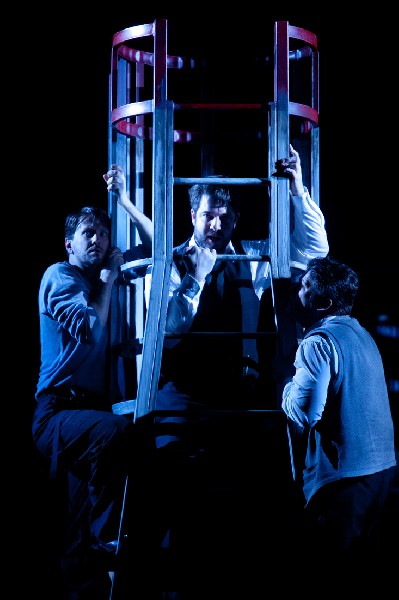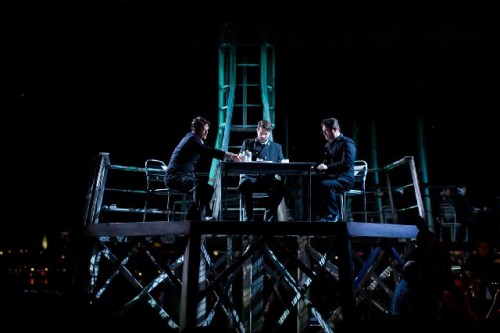The Lighthouse by Peter Maxwell Davies
Boston Lyric's Annex Production at the JFK Library
By: David Bonetti - Feb 12, 2012
The Lighthouse
By Peter Maxwell Davies
Boston Lyric Opera
The John Fitzgerald Kennedy Presidential Library and Museum
Feb. 8,9,11,12
Production Team:
Conductor: David Angus
Stage Director: Tim Albery
Set and Costume Director: Camellia Koo
Lighting Designer: Thomas C.Hase
Cast:Officer 1/Sandy: John Bellemer (tenor), Officer 2/Blazes: Christopher Burchett (baritone)Officer, 3/Arthur: David Cushing (bass)
According to Boston Lyric Opera’s production notes, Peter Maxwell Davies’s “The Lighthouse” has received more than a hundred productions since its 1980 premiere, making it one of the most performed contemporary operas in the repertory.
It is easy to see why. It is brief: one hour and 15 minutes long with no intermission. It is inexpensive to put on: there are only three vocal soloists, none of whom is required to be a Domingo, and only 12 members of the orchestra, most of whom play more than one instrument. And, if presented with the least bit of sensitivity, it is a sure-fire hit.
It is a ghost story of sorts, in the tradition of Henry James’s “The Turn of the Screw” and more pertinently the opera Benjamin Britten created from it. It doesn’t cause the audience to scream or run hysterically from the theater like some of the horror movies that fill multiplexes today. It is subtler, a more adult scary movie - er, opera. One that, if you’re not paying attention, can go over your head. But if you are, it can give you chills and shudders up the spine. (I experienced chills, dear reader, and I am not embarrassed to say so.) I am surprised that it has received only 100 productions in 30-odd years.
Based on a true account of three lighthouse keepers who disappeared without a trace off the coast of Scotland shortly before a long-awaited relief ship arrived, the story is bathed in mystery. What happened to the men who left the table set, their beds unmade, but no clues to their whereabouts? The only living things left is a swarm of rats - but they aren’t telling anything.
The opera opens slowly. In a prologue, a court of inquiry meets in Edinburgh to hear evidence from the officers of the supply ship about what they found at the abandoned lighthouse. All three trios – the members of the court, the officers of the ship, and the lighthouse keepers - are played by the same three singers, and at first, it takes a while to figure out who is exactly who. (And it would take more than one viewing to plot out whether each singer keeps the same psychological profile from role to role.)
Once the action moves to the lighthouse and its keepers, who are experiencing understandable physical and psychological claustrophobia, the story tightens and focuses. These are three guys who should never have been put in a tight space together: One, Blazes (sung by baritone Christopher Burchett, in a company debut) is a high-strung street tough, an amoral drunk and cynic; another, Arthur (bass-baritone David Cushing), is a Bible thumper; the third, Sandy (tenor John Bellemer) is a sentimentalist who tries to hold the ill-matched team together.
The relief ship is way past due. Blazes has run out of drink; tensions rise; noises and lights cause panic; a fight nearly breaks out over a card game between Sandy and Blazes while Arthur sings about the rapidly approaching coming of the Beast. Sandy, the conciliator, suggests that someone sing a song. Blazes says he will go first, but only if the other two have to sing as well.
The singspiel, smack dab in the middle of the opera, is its high mark. Blazes offers up a ballad from the slums, straight out of John Gay by way of Brecht/Weill. He sings the tale of a poor boy who stomps an old woman’s head in order to get the bag of gold hidden under her bed, how his father is blamed and hanged and how his mother dies of grief. It is pretty clear that the story is autobiographical. As the other two grapple with the revelation, Sandy launches into a sentimental love song, a Victorian parlor diversion, which Bellemer presents in a terrific imitation of a cardboard Irish tenor. Finally, Arthur descends from the lighthouse’s tower and delivers a blood-and-thunder religious hymn about doom that soon turns out to be prophetic.
Fog descends; a foghorn sounds; each of the keepers is visited from ghosts from his past. Weakened, Blazes and Sandy fall for Arthur’s invocation of the Cry of the Beast and in panic they run out on the jetty to disappear forever. (That’s the moment when I got shivers up my spine.)
In his production notes, Davies suggests that the lights that drive the keepers into their final madness are merely the lights of the approaching supply ship. But that seems too pat, and Boston Lyric’s more ambiguous ending production keeps the mystery alive. What did happen to the lighthouse keepers and why no one will ever know.
Davies, the Queen's composer, is, of course, most responsible for the work’s success. His “orchestra,” which includes only a single violin, viola, cello and bass, is dominated by winds and reeds and such unusual instruments for opera as guitar, banjo, bass drum, celeste, referee whistle, flexatone – whatever that is – and an out-of-tune-upright piano. With such a range of orchestral color he is able to paint evocative sound pictures – the sound of gulls, the waves, the foghorn – and suggest, like Bernard Herrmann in “Psycho,” deteriorating psychological states. His centerpiece of three songs, each a different late 19th century genre, is pure genius. In the midst of a spiky, jagged, often atonal score, he gives the audience the pleasure of hearing melody, familiar melody, that also requires non-traditional instrumentation – a banjo for Blazes ballad, the out-of-tune parlor piano for Sandy’s ballad, the bass drum for Arthur’s Salvation Army hymn.
Davies wrote his own libretto, in which he clearly demonstrates his understanding of the importance of verbal repetition for the opera audience, which has so much to process at once – music, drama, visuals, text. “Black” is his leitmotif. The ocean is black, the sky is black, the birds are black, the rats are black. Unspoken but understood is that the mood is black.
The BLO production was pretty much perfect, although its major conceit, setting the work in a room at the JFK Library with a window wall that looks out over Boston harbor, didn’t work out. All I could see were some distant lights in East Boston. Otherwise, the windows were so dark that it could have been set in a basement. But the set, by Camellia Koo in her company debut, was just right – a stunted tower that evoked a lighthouse with a raised platform where the action occurred. That the jetty was composed of hundreds of sailors’ coats, suggesting that the story was in endless repeat, was a smart touch. Director Tim Albery’s hint at the very end that the three members of the supply ship would replace the three missing keepers added to the work’s existential dread. Lighting designer Thomas C. Hase contributed to the work’s creepiness. Darkness punctuated with bright lights added to the ominous mood.
Albery, in his company debut, had a couple of other thrilling directorial moments, prime among the moment when the members of the supply ship open the lighthouse door and the rats come streaming out. All three sailors stomp and flail in a perfect stage picture of how most of us would react to an army of terrified rats descending upon us. And some of us in the audience, at least me, were made anxious that the fleeing rats would soon end up running up our legs.
Musically, the evening was also close to perfect. Company music director David Angus exploited his limited orchestra’s extremes of color for everything it was worth from the tweety winds evoking gulls at the start to the drums signaling doom at the end. The three vocalists were superb. It would be hard to single out a single performer but as Blazes, Christopher Burchett, an artist at the start of a career, promises great things to come.
With the abrupt shutting down of Opera Boston last month, opera in Boston has gone once again into crisis mode. Has anyone tracked how many times it has been in such straits? From what I’ve observed in a relatively brief time reporting on the scene (and with 20-year old memories) smaller scale productions here tend to be the most successful. (Although Sarah Caldwell essayed Berlioz’s “Les Troyens,” Verdi’s “Don Carlos” and Prokofiev’s “War and Peace” to brilliant effect.) Last year, in its small-scale off-site “Annex” production of Victor Ullmann’s “The King of Atlantis: Death Quits,” Boston Lyric Opera had its biggest hit. Small-scale semi-staged performances of early operas by both the Boston Early Music Festival and Boston Baroque at Jordan Hall have also been greatly satisfying. Under “Jimmy” Levine, the Boston Symphony Orchestra has offered little to the opera lover. (Michelle deYoung, anyone?) Seiji, with his semi-staged productions of the New Viennese School, was better by far.
Maybe local companies should continue to think small. Until someone builds an appropriate theater and someone comes up with the funds – dream on - we will probably never get to see major works here by Wagner and Verdi in productions they require, but interesting, fun, satisfying and brilliant works by other composers often go languishing. Boston Lyric’s next production of Rossini’s “Barber of Seville” (March 9-18) is of an opera that hardly languishes: It is one of the most popular works in the repertory for good reason. (And I look forward to seeing it – one can never see too many “Barbers.”) It’s a relatively small-scaled work, which the company should be able to pull off, but it requires a couple of great singers. The company achieved that last year with its production of Handel’s “Agrippina.” Who can soon forget the incandescent singing of Kathleen Kim and Anthony Roth Costanzo?
If local forces supporting opera, wherever and however it appears, can focus on what is possible, we might have a future for opera here. Who needs a mediocre production of “Macbeth,” a soporfic “Cardillac” and disastrous productions of “Fidelio” and “The Midsummer’s Night Dream” when we can have great evenings featuring operas such as “The Lighthouse” and “The Emperor of Atlantis”?






